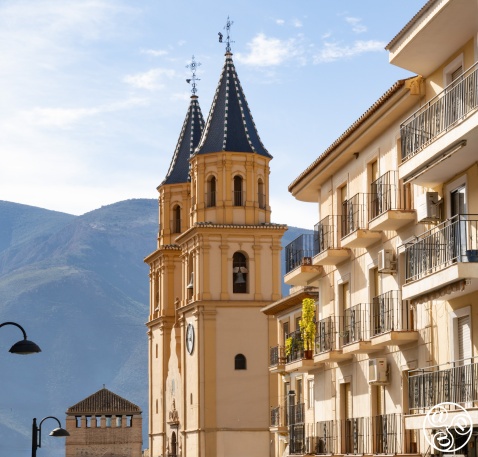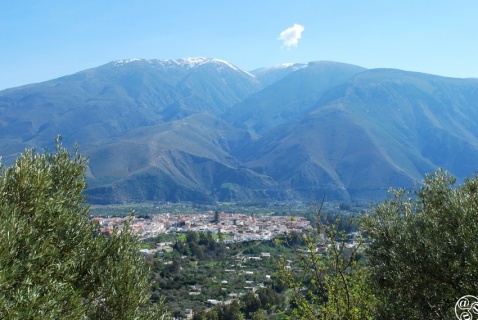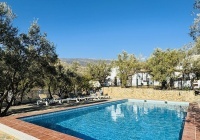
The village of Órgiva- Iglesia Santísimo Cristo De La Expiración |
|

The village of Órgiva- Iglesia Santísimo Cristo De La Expiración |
|
Orgiva
Located in the fertile valley of the Guadalfeo River, Órgiva is the largest town in the western Alpujarras. At an altitude of 450m, Órgiva enjoys a milder climate than many other places in the Alpujarras and is surrounded by olive, lemon and orange groves. Chris Stewart of 'Driving Over Lemons' fame lives nearby and his books have done much to boost the local tourist industry and attract more northern Europeans, mainly from the UK, to settle in the area. At last count, EU expats made up about a tenth of the town's 5,000 inhabitants. Órgiva has a somewhat bohemian atmosphere, as it is also a magnet for those seeking an alternative lifestyle. It has a population of around 5,700.
History
Órgiva has been identified as the Greek colony of Exoche, mentioned by the geographer Ptolemy. The first written references to the town appear in the writings of al-Udri (eleventh century) and al-Idrisi (twelfth century), with the names of yuz Aryuba and hisn Órgiva, respectively, as an administrative district and castle of the Cora de Elvira. More >
Characterful Andalucian farmhouse in the Alpujarras with six bedrooms, set in tranquil grounds with pool, enjoying a rural mountain location yet close to local amenities.
Quality villas and holiday cottages in La Alpujarra and other magical locations of Spain.
Things to see in the town
Parroquia de Nuestra Señora de la Expectación
A former Muslim mosque that was converted into a church during the reconquest by the Catholic Monarchs. The presbytery houses the sculpture of Cristo de la Expiración, the patron saint of Órgiva, as well as other works of merit, such as the Virgen del Carmen, for which six hundred reales were paid in 1694. The sculpture of Cristo de la Expiración dates from 1599 and is attributed to the school of Juan Martinez Montañés, although it was carved in Granada by unknown artists. The church is located in Plaza Garcia Moreno.
Barrio Alto
Barrio Alto (upper district) is one of the charming parts of Órgiva. The traditional village architecture has remained. Stroll up Calle Barrio Alto and the steeper Calle Ermita to the hermitage of San Sebastián, which at is located at the highest point in the town and offers the best panoramic views of the sourrounding countryside. Lookout for 'Ventana de Orgiva' the giant window frame, perfect for social media posts. Return by Calle Estacion (where long gone are the stations of the cross) where some of the houses have floral decorations.
San Sebastián hermitage
It is said that the foundations of this chapel were part of a Visigoth fortress, if not they were certainly part of a moorish castle located strategically on the highest point of the city. The chapel was constructed in 1599 by the Archbishop of Granada to give thanks to San Sebastian, the patron saint of Orgiva for the saving the (remaining) population from a bubonic plague. The building is simple in style with a single octagonal nave and an entrance archade the supports a belfry with a single bell and a small statue of San Sebastian. During the Spanish Civil War in 1936, the building was severely damaged and rebuilt in 1951, modifying the old façade and preserving the primitive plaster altarpiece dedicated to San Sebastián. Located in Calle Ermita.
Plaza de la Alpujarra
The square was built in 2004 and is flanked by two long shaded colonnades with ceramic representations of the different villages of the Alpujarra. The Plaza de la Alpujjara is also the location of the Tourist Office which doubles as an interpretation centre for the interesting history of the local mining industry.
Casa Palacio de los Condes de Sástago
The Palace of the Counts of Sástago was built between the 16th and 17th centuries, an fine example of Mudejar architecture. The castellated tower is particularly well preserved. In 1492, the Catholic Monarchs completed the reconquest and overthrew the Nasrid Dynesty from the Alhambra Palage in Granada. The peace treaty permitted the moors to settle in the Alpujarras. Seventy years later, between 1568 and 1571, there was a major Moorish uprising. The Marqués de Mondéjar lead the Spanish campaign marching from Granada in January 1569 and reached Órgiva just in time to rescue Christians held captive in this tower. Today the palace is the town hall. Located in Yañez street.
Agustín Martín Zaragoza Cervantes Room
The Agustín Martín Zaragoza Cervantine Room of the Hurtado de Mendoza Library houses one of the most important Don Quixote collections in Spain. The collection was started in 1967 by the Honorary Librarian Agustín Martín Zaragoza, a Don Quixote enthusiast, who received a copy from the then Prince Don Juan Carlos, who signed it as King during his official visit to Órgiva in 1994. At present, the collection consists of more than 300 editions of Don Quixote, more than 600 essays & biographies and more than 80 copies in different languages. The collection also includes numerous paintings, which are displayed at the entrance to the library. Outside is and imposing statue of Don Quixote. Located in Calle Ramón y Cajal.
Opening Times:
Monday to Friday, 10:00 - 13:00 hrs and 17:00 - 20:00hrs.
Tel: 958 78 51 76.
Plaza de las Culturas
The square is a meeting place that pays homage to the cultural diversity of the municipality (more than 100 different nationalities live in Órgiva). In the centre of the square is a sculpture by José Vera of three hands holding a ball, symbol of the world, by Publio Terencio Africano. At one end of the square there is a wall representing a waterfall in which the five continents are reflected, as a sign of the city's cultural wealth.
The Gallinero Museum,
also known as the Ruiz Almodóvar Museum Archive, has a collection of drawings and paintings dedicated mainly to José Ruiz de Almodóvar, with more than 1,000 drawings and an exhibition of his work, mainly portraits, in which he became a specialist in pastels. It is a red building that hosts music concerts and other cultural activities during the summer. Located in Fuente Mariano street.
Things to see outside the town
Molino de Benizalte
The Benizalte mill dates from the 16th century and is located on the outskirts of Órgiva, on the far side of the river Chico on the Camino de Benizalte. The large building whose original function was to press olives is not open to the public.
Ruinas del Castillo
At the top of a hill, almost 900 metres above sea level, in front of the town of Órgiva, stand the remains of an ancient Arab fortress, the Castillejo de Órgiva. The original complex has long been destroyed and is partly covered by a fort built during the Spanish Civil War. Old pottery finds are abundant here, even on the sides or flanks of the fortress, where we can see common pottery pieces, large vases, tiles, bricks, etc., perhaps from the Almoravid period (mid-twelfth century). The ruins are located 3 kilometres south of the city, on the left bank of the Guadalfeo River, in a place known as the Barranco del Castillejo.
Minas de Sierra Lújar
Mining in the Sierra de Lújar dates back to Roman times with the extraction of silver and lead. At the end of the nineteenth century, with the liberalisation of mining, the number of companies and operations locally increased to 59 lead mines and five copper mines, employing a total of 2,000 workers. The difficulty in finding areas with high lead content led to the discovery of metallurgical fluorite (F2Ca. The exploitation of this mineral, also known as wolframite, has taken place since the 1970s. The Plaza de la Alpujjara is also the location of the Tourist Office which doubles as an interpretation centre for the interesting history of the local mining industry.
Countryside Walks
Órgiva offers a great variety of walking routes such as Camino de los Olivos Centenarios, Circular de Bayacas, Camino de lso Rojos, Ruta de los Mineros, Ruta BTT, Circular Órgiva-La Chuca-Río Guadalfeo-Órgiva, Paseo de la Vegueta and Caminos de la Alpujarra.
Bus Service
There is a bus service from Órgiva to Granada, Ugíjar, Trevélez, Alcutar and Berja. More >
Gastronomy
Typical dishes to try in Órgiva are puchero de hinojos (fennel stew), sopa de ajo (garlic soup), conejo al ajillo (rabbit with garlic), cordero a la brasa (roast lamb) and solomillo a la pimienta (pork loin with peppers). The city's most popular dessert is potaje de castañas (chestnuts in syrup).
Festivals
Popular festivals in Órgiva are Día del Santísimo Cristo de la Expiración, Reales Ferias y Fiestas de Órgiva, Feria de Turismo, Artesanía y Alimentación Hecho en la Alpujarra and Fiestas de San Sebastián. Fiesta de San Sebastián is on 20th January and the Feria Grande is at the end of September and beginning of October. More >
Tourist Office
The Órgiva tourist office of is located in the Plaza de la Alpujarra More >
Hotels
Hotel Tarary is 1km south of town (958 784 525). As well as a beautiful swimming pool and extensive gardens, its restaurant uses the hotel′s own farm produce. Free parking.
Camping
There is a campsite 1km outside the town on the A-348 with restaurant and weekly live music. It also rents bungalows and cabins.
NEARBY PLACES
The neighbouring villages to Orgiva are Lanjarón, Cañar, Suportujar, Velez de Benaudalla and Almegijar.


